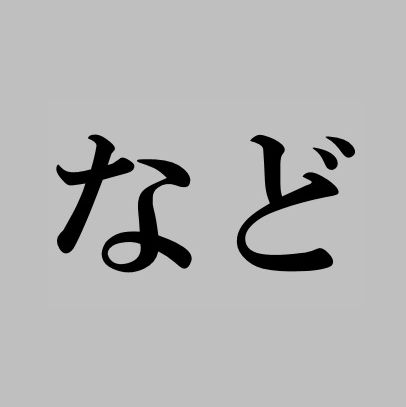October 12, 2016
Word Wise: Etc.?
など、など、等 Nado
By Richard Medhurst
 Apprentice translators from Japanese to English soon encounter the など issue. Lists are typically followed by a など, and they may pop up with alarming frequency. Excessive use of “etc.” in English would be considered bad style, but Japanese follows different rules and we must deal with it.
Apprentice translators from Japanese to English soon encounter the など issue. Lists are typically followed by a など, and they may pop up with alarming frequency. Excessive use of “etc.” in English would be considered bad style, but Japanese follows different rules and we must deal with it.
It often goes without saying in English that there are other members of a group being discussed. One clear example comes in headlines and headings. Here is a recent NHK headline: 北海道東部 土砂災害や川の氾濫など厳重警戒 . In translation, it might appear in a somewhat shorter form as “Landslide and Flood Warnings in Eastern Hokkaidō.” The reader would not take this to mean that there were no other kinds of warnings. Or with a structure like たとえばXYZなど, it is already plain that an example has been selected from several possibilities, so there is no need to put anything for など.
In an ideal world, a lot of instances of など would probably disappear in English. But translators frequently have to swallow their doubts. More often than not they don’t have enough information on whether other important members exist or not to convince checkers or clients that nothing is required. Given the frequency of など, it is best to vary the translations to make the text as natural as possible.
One way to translate is with “such as,” as in “countries such as China, South Korea, and Thailand.” Another possibility is “including,” as in “local landmarks including a temple and a waterfall.” Translators may also use “like,” as in “companies like Sony and Panasonic,” although it may appear too informal in some contexts. Or turn it around with “and other. . .” The first example above then become “China, South Korea, Thailand, and other countries.”
Sometimes only one item is given. Recently faced with the phrase アワビなど, it took me some time to decide from the context that this should be “abalones and other seafood,” although in other contexts the group might be “shellfish,” “food,” or another term entirely.
One further possibility is “and more,” which I am more likely to use when drumming up excitement. “Visitors can enjoy dance performances, traditional music, and more.” I cannot recall using “and so on.” The maligned “etc.” does, however, come in useful in PowerPoint presentations, where there is a dearth of both context and space.
If you have suggestions on how to deal with など, ideas of words to cover, or anything else you’d like to say, please contact us at info@swet.jp.

Comments:
There are no comments for this article yet.
Add your comment:
If you are a SWET member, log in to post a comment immediately. Comments are moderated for non-members.